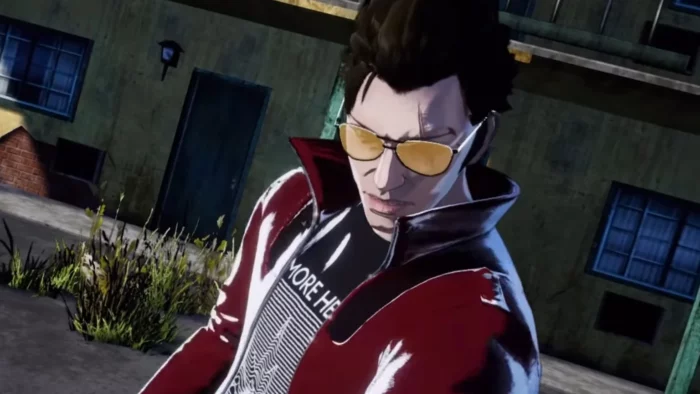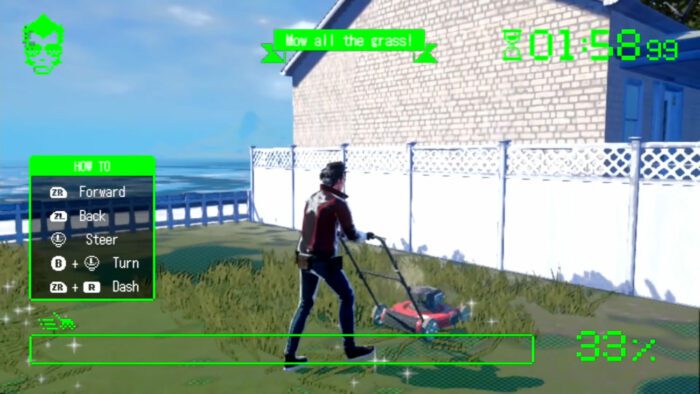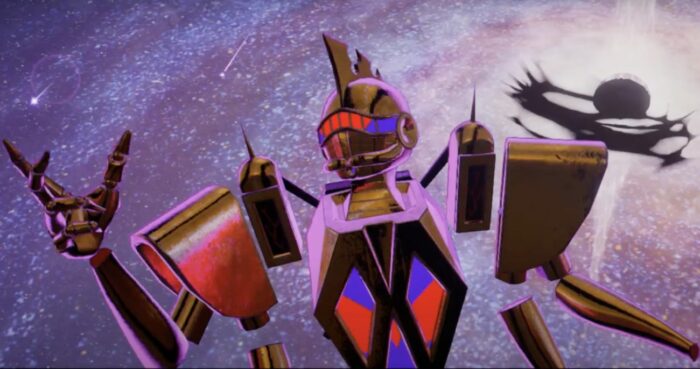SUDA51 is one of gaming’s most fascinating creators to me. There tends to be a pretty consistent theme with his works: there’s usually an element of surrealism; there’s meta, self-referential humor; there’s usually extreme and often times comical amounts of violence. He actually stepped away from the director’s chair for a while, though, and only returned to it with Travis Strikes Again: No More Heroes a few years ago. I was excited for it, and was subsequently let down. The presentation felt drab, and the action was boring after just an hour of play. I’m happy to report, though, that No More Heroes III is a triumphant return to form for the auteur game developer. If you’re a fan of his previous works, that is.
For those not in the know, the series as a whole is about Travis Touchdown, an otaku and something of a loser, buying a lightsaber knockoff in an internet auction and fighting his way through the ranks of the United Assassin’s Association to become the number one killer in the whole world. The first game became a smash hit for the Wii, and it’s easy to see why; it combines elements from all corners of pop culture to create a gaming experience that really should not work as well as it does. I love the first game, and I enjoy the second game a ton as well, although it wasn’t directed by SUDA51 and in the years following its release, many view it as an inferior sequel. Either way, both games distill anarchy into an interactive format, and that’s something to treasure.

It’s why I felt so let down by Travis Strikes Again. A huge part of what made the original two games work was their presentation. From stellar voice acting from industry veterans like Robin Atkin Downes to the unpredictable narratives, the games define the phrase “style over substance.” TSA seemingly had a much smaller budget and it shows. There was almost no voice acting in it, none of the hyper-kinetic and energetic cut scenes, and perhaps most damning of all, forgettable boss fights. It’s why I felt a touch skeptical when No More Heroes III was announced during the summer’s Nintendo Direct. But I’m happy to say that everything that makes the first two games so good is here, intact, and arguably better than ever.
This time around, Travis has moved back to his hometown of Santa Destroy, and is once again staying at the No More Heroes Motel. He has distanced himself from his wife Sylvia, as well as their two children since assassins kept showing up at their doorstep. Life kind of bites, but he’s doing mostly okay living with his two protégés Shinobu and Bad Girl, when out of nowhere, aliens come to Earth, and they’re lead by Fu, a big blue dude with severely homicidal tendencies. As shown in the game’s beautiful animated opening, Fu came to Earth twenty years ago and befriended a young boy named Damon. He left, promising to return in twenty years, and now that he’s here, him and his followers want blood. Sylvia, being the ever enigmatic and kind of creepy organizer of UAA tournaments, does just what she’s done in the past: she places Travis at number 11, and organizes death matches between him and the aliens.
Your enjoyment of the game is definitely going to depend heavily on your reaction to the above paragraph. Even though it’s been over a decade since the last mainline installment came out, No More Heroes III does nothing to catch new players up to speed. Characters from the franchise’s entire history turn up here, as well as even more from some of SUDA51’s other works, turning this entry into something of an Avengers for the auteur. TSA flirted with this; for instance, in the very beginning of that game, Dan Smith from SUDA51’s outstanding Killer 7 shows up. Here, the cuts go even deeper, with a few from the early days in his career popping up and doing nothing to explain who they are and what they’re doing there.
No More Heroes III is unashamedly itself. What I mean by that is that there’s little here to cater towards modern gaming sensibilities. Sure, there have been some QoL additions to the franchise formula, but on the whole, the structure, pacing, and story fall right in line with the rest of the series, for better and for worse. For me, that’s exactly what I wanted from this entry. For others who may not have enjoyed the originals, or don’t know what they are, results may vary.

Like in previous entries, Travis has to earn money to pay for the death matches he participates in, and also like previous entries, you earn cash by completing a mixture of menial mini games that emulate tedious real life jobs, and by fighting enemies in combat arenas. If I had a complaint about this particular entry’s structure, it’s that the job-based mini games feel more superfluous than ever before. In the first game, they were thematically relevant in how they deconstructed just how far a player would go for a good time, and in the second they were enjoyable but tough 8-bit mini games that really helped set them apart. Here, there doesn’t seem to be too many reasons to go through them unless you really enjoy them. And they’re tedious by design, so the odds of you enjoying them are fairly low.
Thankfully, combat has been refined to be the best the series has ever seen. It’s standard stuff, but executed exceptionally well. You can alternate between light and heavy attacks with Travis’s beam katana Bloodberry, you can perform wrestling moves if you get behind a foe, and you can perform special abilities that you obtain early on with helpful benefits such as behind able to slow enemies down around you or flying forward in an over the top death kick. There is just enough enemy variety that, honestly, I never grew bored by combat even in the final stages of the story. And believe me when I say that you’ll be doing a lot of fighting.
The way you unlock the next death match, apart from earning enough money and buying your way in, is by fighting through Designated Matches. These are specifically tailored fights where you are often put up against a tough group of enemies, and it’s in these that the PvE combat shines the most. The game does a good job of mixing up the groups you’ll be fighting, and each enemy type requires a specific strategy to bring down. For instance, one enemy type will spawn a shield that can be shot forward, meaning you have to find a way around their back. Another enemy type hops around like a maniacal frog, and will jump at you erratically.
It helps that the combat looks and feels great, too. When an enemy’s health is brought down enough, you can perform a death blow, which is where Travis will say something extremely vulgar and time will slow down enough for you to anticipate the explosion of colorful blood that comes from taking an enemy’s head off. There’s also an excellent flow to it once you have all your skills. Travis’s Beam Katana has a battery which can be refilled either by shaking it, or more satisfyingly by stunning an enemy and performing a wrestling move when they’re dazed. It lends a sort of break neck and chaotic pace to the combat, which perfectly suits the over the top world and characters.
Combat truly shines in the game’s many boss fights, and the quality is just as high as it was in previous entries. There’s quite a bit of expectation-subverting; often times, a boss that’s advertised will be killed by someone else and then you’ll have to fight them instead. The joke wears thin after a while, but thankfully the ensuing battle is almost always worth putting up with repetitive humor. Each one is a full on, no holds barred brawl of learning attack patterns and knowing when to strike. They’re decently challenging, too. I played on the standard difficulty (called “Bitter”) and found myself having to redo a few of the fights. Outside of a small handful of instances, I largely felt determination when I died. It taps into the “one more go” feeling of retro games, and it’s clear an immense amount of thought was put into each one. The bosses have always been a large part of the appeal of the series, and No More Heroes III certainly carries that tradition on proudly.

The final thing I’d like to discuss is this game’s open world. The first is notorious for just how barren its version of Santa Destroy is, and the second game did away with it altogether in favor of menu based world traversal. Here, it’s still pretty damn barren, but it at least puts collectibles for you to find. You can go hunting for scorpions to help a guy make ramen, find lost kittens, and a few more things that don’t amount to much but at least offer some incentive to explore the world. It doesn’t really come anywhere close to the standard of most modern open world games, but it doesn’t really need to. Each area of the map is small enough that going from place to place rarely feels tedious. Plus, there are T-shirt aliens scattered around that will give you cool new duds for completing various challenges. Like the other collectibles, this doesn’t really add all that much to the game, but I loved seeing what kind of design would pop up next. More than a few of the original T-shirts in this game are ones I’d love to own in real life.
Your mileage with No More Heroes III is going to largely come down to your tolerance for SUDA51’s strange and sometimes baffling game design choices. Many of the flaws of previous games are here, and depending on who you are, that’s either a good thing or a bad thing. For me, the series wouldn’t quite be what it is without them. No More Heroes, as a franchise, is packed to the brim with personality and style, and part of that does come from its refusal to follow traditional game design conventions. The story will likely be lost on people unfamiliar with SUDA51’s previous work, too. But to me, making this kind of niche product was the right move. NMH as a brand has been gone for quite a long time, so making something that fans will enjoy seemed like the best way to drum up some goodwill for this newest entry. For me, No More Heroes III is what I wanted when I heard that it was releasing this Fall. Even if we never get another entry, I’m glad we had one last wild outing with Travis and all of his homicidal pals.
Even if you’re not a fan, though, I would highly recommend listening to the game’s soundtrack. It’s offbeat and incredible, and has what might be my favorite shop theme in all of gaming.

